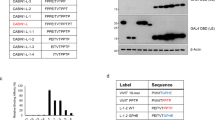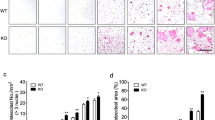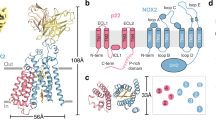Abstract
CALCINEURIN is the only protein phosphatase known to be under the control of Ca2+ and calmodulin1,2. It is targeted by immuno-suppressive drugs and has a critical role in T-cell activation3,4. It is specifically inhibited by immunosuppressant immunophilin complexes, which enabled its function in regulating a wide range of cellular responses to Ca2+-mobilizing signals5,6 to be identified. Calcineurin in situ is 10–20 times more active than in the purified form and is subject to a time- and Ca2+/calmodulin-dependent reversible inactivation that is facilitated by small, heat-stable molecules7. Here we identify a factor that prevents the inactivation of calcineurin in vitro and in vivo as the enzyme superoxide dismutase, which indicates that inactivation may be the result of oxidative damage to the Fe–Zn active centre of calcineurin. The redox state of iron provides a mechanism to regulate calcineurin activity by desensitizing the enzyme and coupling Ca2+-dependent protein dephosphorylation to the redox state of the cell. The protection of calcineurin against inactivation by superoxide dismutase constitutes a new physiological role for this enzyme which enables the Ca2+-dependent regulation of cellular processes to be modulated by the redox potential.
This is a preview of subscription content, access via your institution
Access options
Subscribe to this journal
Receive 51 print issues and online access
$199.00 per year
only $3.90 per issue
Buy this article
- Purchase on Springer Link
- Instant access to full article PDF
Prices may be subject to local taxes which are calculated during checkout
Similar content being viewed by others
References
Klee, C. B., Draetta, G. & Hubbard, M. J. J. Adv. Enzymol. 61, 149–199 (1987).
Kincaid, R. L., Higuchi, S., Tamura, J., Giri, P. R. & Martensen, T. M. Adv. Protein Phosphatases 6, 73–99 (1991).
Liu, J. et al. Cell 66, 807–815 (1991).
Jain, J., Loh, C. & Rao, A. Curr. Opin. Immunol. 7, 333–342 (1995).
Liu, J. et al. Biochemistry 31, 3896–3901 (1992).
Crabtree, G. R. & Clipstone, N. A. Annu. Rev. Biochem. 63, 1045–1083 (1994).
Stemmer, P. M., Wang, X., Krinks, M. H. & Klee, C. B. FEBS Lett. 374, 237–240 (1995).
Delabar, M. et al. Eur. J. Biochem. 166, 181–187 (1987).
Fridovich, I. Adv. Enzymol. 58, 61–97 (1986).
Carrico, R. J. & Deutsch, H. F. J. Biol. Chem. 244, 6087–6093 (1969).
Fridovich, I. Annu. Rev. Biochem. 64, 97–112 (1995).
Rouault, T. A. & Klausner, R. D. Trends Biochem. Sci. 21, 174–177 (1996).
King, M. M. & Huang, C. Y. J. Biol. Chem. 259, 8847–8856 (1984).
Qin, K.-F., Khangulov, S., Liu, C. & Huang, C. Y. FASEB J. 9, A1347 (1995).
Yu, L., Haddy, A. & Rusnak, F. J. Am. Chem. Soc. 117, 10147–10148 (1995).
Griffith, J. P. et al. Cell 82, 507–522 (1995).
Kissinger, C. R. et al. Nature 378, 641–644 (1995).
Strater, N., Klabunde, T., Tucker, P., Witzel, H. & Krebs, B. Science 268, 1489–1492 (1995).
Martin, B. L. & Graves, D. J. J. Biol. Chem. 261, 14545–14550 (1986).
Wang, H. & Graves, D. J. Biochemistry 30, 3019–3024 (1991).
Cyert, M. S. & Thorner, J. Mol. Cell. Biol. 12, 3460–3469 (1992).
Hirata, D., Harada, S-i., Namba, H. & Miyakawa, T. Mol. Gen. Genet. 249, 257–264 (1995).
Mendoza, I., Rubio, F., Rogriguez-Navarro, A. & Pardo, J. M. J. Biol. Chem. 269, 8792–8796 (1994).
Paterson, D., Warner, H. R., Fox, L. M. & Rahmani, Z. Mol. Genet. Med. 4, 79–118 (1994).
Liu, X. F. et al. J. Biol. Chem. 267, 18298–18302 (1992).
Hubbard, M. J. & Klee, C. B. in Molecular Neurobiology, A Practical Approach (eds Chad, J. & Wheal, H.) 135–157 (IRL, Oxford, 1991).
Ingebritsen, T. S. & Cohen, P. Science 221, 331–337 (1983).
Blumenthal, D. K., Takio, K., Hansen, K. & Krebs, E. G. J. Biol. Chem. 261, 8140–8145 (1986).
Blumenthal, D. K. et al. Proc. Natl Acad. Sci. USA 82, 3187–3191 (1985).
Beauchamp, C. & Fridovich, I. Anal. Biochem. 44, 276–287 (1971).
Author information
Authors and Affiliations
Rights and permissions
About this article
Cite this article
Wang, X., Culotta, V. & Klee, C. Superoxide dismutase protects calcineurin from inactivation. Nature 383, 434–437 (1996). https://doi.org/10.1038/383434a0
Received:
Accepted:
Issue Date:
DOI: https://doi.org/10.1038/383434a0
This article is cited by
-
Protein phosphatases of Saccharomyces cerevisiae
Current Genetics (2019)
-
Preventive effect of Agnucastoside C against Isoproterenol-induced myocardial injury
Scientific Reports (2017)
-
Lithium suppression of tau induces brain iron accumulation and neurodegeneration
Molecular Psychiatry (2017)
-
Biochemical basis of synergism between pathogenic fungus Metarhizium anisopliae and insecticide chlorantraniliprole in Locusta migratoria (Meyen)
Scientific Reports (2016)
-
Deep sequencing analysis of transcriptomes in Aspergillus flavus in response to resveratrol
BMC Microbiology (2015)
Comments
By submitting a comment you agree to abide by our Terms and Community Guidelines. If you find something abusive or that does not comply with our terms or guidelines please flag it as inappropriate.



